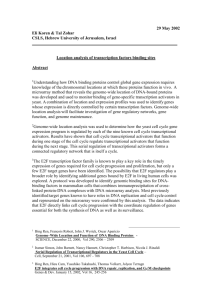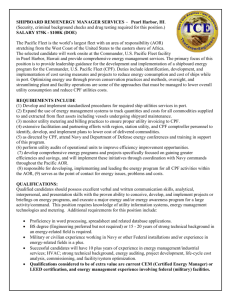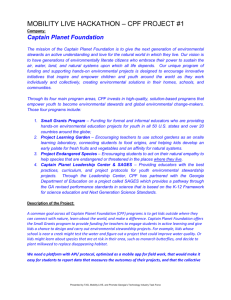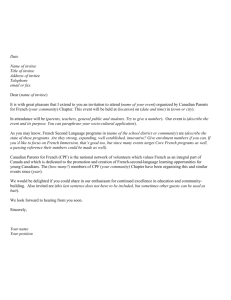SI Appendix 1
advertisement
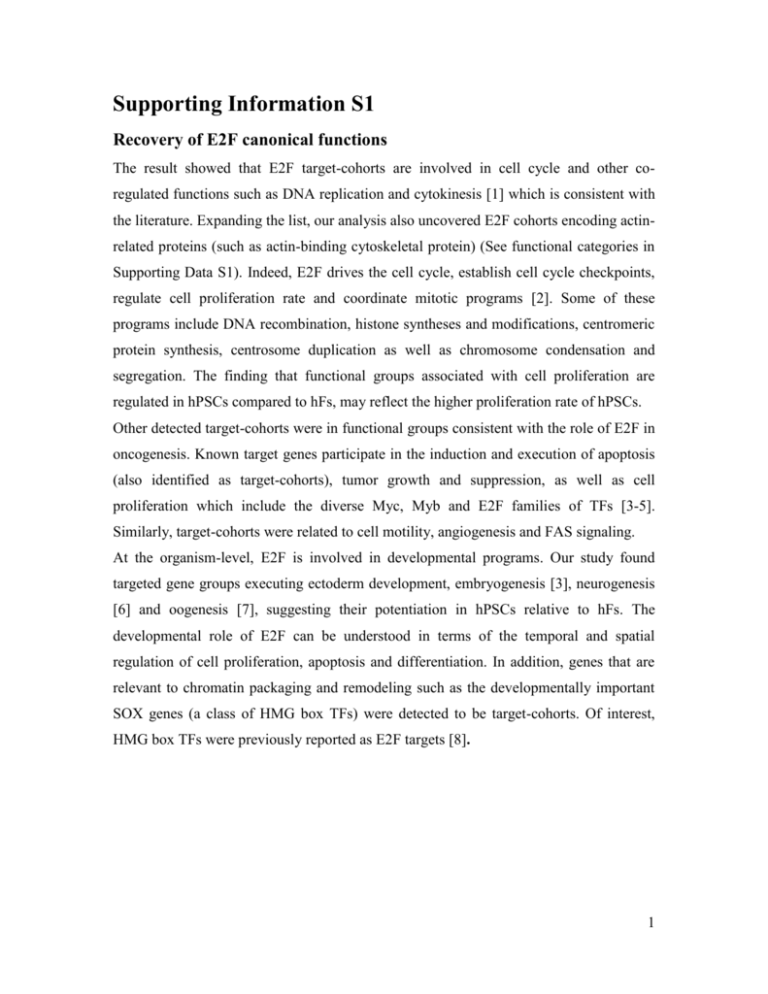
Supporting Information S1
Recovery of E2F canonical functions
The result showed that E2F target-cohorts are involved in cell cycle and other coregulated functions such as DNA replication and cytokinesis [1] which is consistent with
the literature. Expanding the list, our analysis also uncovered E2F cohorts encoding actinrelated proteins (such as actin-binding cytoskeletal protein) (See functional categories in
Supporting Data S1). Indeed, E2F drives the cell cycle, establish cell cycle checkpoints,
regulate cell proliferation rate and coordinate mitotic programs [2]. Some of these
programs include DNA recombination, histone syntheses and modifications, centromeric
protein synthesis, centrosome duplication as well as chromosome condensation and
segregation. The finding that functional groups associated with cell proliferation are
regulated in hPSCs compared to hFs, may reflect the higher proliferation rate of hPSCs.
Other detected target-cohorts were in functional groups consistent with the role of E2F in
oncogenesis. Known target genes participate in the induction and execution of apoptosis
(also identified as target-cohorts), tumor growth and suppression, as well as cell
proliferation which include the diverse Myc, Myb and E2F families of TFs [3-5].
Similarly, target-cohorts were related to cell motility, angiogenesis and FAS signaling.
At the organism-level, E2F is involved in developmental programs. Our study found
targeted gene groups executing ectoderm development, embryogenesis [3], neurogenesis
[6] and oogenesis [7], suggesting their potentiation in hPSCs relative to hFs. The
developmental role of E2F can be understood in terms of the temporal and spatial
regulation of cell proliferation, apoptosis and differentiation. In addition, genes that are
relevant to chromatin packaging and remodeling such as the developmentally important
SOX genes (a class of HMG box TFs) were detected to be target-cohorts. Of interest,
HMG box TFs were previously reported as E2F targets [8].
1
E2F functional motifs enrichment in core and proximal promoters
An unbiased location analysis of ChIP-chip E2F1 binding sites in Hela cell line revealed
that 51% of these sites were localized at the transcription start site (TSS), while 82% falls
within 1 kbp of the TSS. Only 4% overlaps the 3’ end of transcripts [9]. A similar
localization of ChIP-chip E2F4 and E2F6 binding sites in the core promoters were also
reported [10]. In addition, the promoters of cell cycle genes (canonical E2F targets)
showed an enrichment of binding sites between -400bp to +100bp and peaking very near
to the TSS, compared to a typical eukaryote promoter [8]. All these indicate functional
motif enrichment in core and proximal promoters.
The role of E2F1 in basal transcription further supports the notion of E2F functional
binding in core promoters. The TF was shown to be capable of interacting with
components of Pre-Initiation Complex (PIC), required for transcription initiation. These
include TFIIA, TFIID, TBP (subunit of TFIID) and TFIIH [11-14]. E2F1 may stabilize
the binding of TBP to TATA-containing promoters in the first step of PIC assembly
beside the recruitment of TBP to TATA-less promoters [8].
Further support for the claim of E2F functional binding in core promoters comes from the
genome-wide E2F co-localization with PIC components. E2F1 was found within 1 kbp of
83% of POLR2A (subunit of RNA polymerase II) sites, and within 1kbp of the TSS in
90% of POLR2A-occupied promoters [9]. The genomic binding profiles of E2F1, E2F4
and E2F6 are similar to POLR2A and TAF1 (subunit of TBP) [10]. However, it is not
known whether the interactions of E2F1 with the basal complex components are
conserved among the other E2F.
2
Pseudo-algorithm for target-cohort analysis
1. For each pre-defined gene group, the set of I unique target propensity thresholds
is denoted as T = {ti: i=1, 2, …, I-1, I} and t1> t2 > … > tI-1 > tI.
2. Member genes in a group were split into two subsets- (a) above or equal to the
target propensity threshold and, (b) below the threshold.
3. Compute score increment between high and low target propensity subsets ∆Si.
(first column of array A)
4. Obtain J = 10,000 gene groups of the same size by assigning member genes with
scores from randomly-sampled genes in the microarray dataset without
replacement. Similarly, compute score increments between high and low target
propensity subsets ∆Si j for jth sample (in j+1 column of array A)
5. P-value of ∆S for threshold ti = P (∆Si) = Pi = (# {∆Si j: ∆Si j ≥ ∆Si} +1) / J. (in
column one of array B).
6. P-value of ∆S for threshold ti of kth sampling = P (∆Si k ) = Pi k = (# {∆Si j: ∆Si j ≥
∆Si k} +1) / J. (in k+1 column of array B)
7. Interim P-value for tested gene group, taking into account all threshold ti = P =
min{Pi}. (in first column of array C)
8. Interim P-value for mth sample, taking into account all threshold ti = Pm = min
{Pim}. (in m+1 column of array C)
9. Computed P-value = Pc = (# {Pm :Pm ≤ P} +1)/J (in array D)
S 1
S11
S12
S 2
S 21
S 22
...
...
...
1
SI 1 S I 1 S I21
SI
S I1
S I2
Array A
P P1
P1 ... P J 1
Array C
...
...
...
...
...
PJ
S1J 1
S 2J 1
...
S IJ11
S IJ 1
S1J
S 2J
...
S IJ1
S IJ
P1
P11 P1 2
P2
P21 P22
...
... ...
PI 1 PI11 PI 21
PI
PI1 PI 2
Array B
... P1 J 1
... P2J 1
...
... PI J11
... PI J 1
P1 J
P2J
...
PI J1
PI J
Pc
Array D
In the event where no sample in J samplings has more significant value than the tested
one, the P-value is conservatively reported as J-1 in three associated steps. Hence,
3
computed P-values are significantly biased toward larger values for smaller P-values. In
addition, two sampling characteristics build in a highly stringent test, minimizing
unwarranted high significance. Firstly, it assigns large P-values to gene groups with
similar scores for correlated members (i.e., no evidence of score increment across target
propensity thresholds). Secondly, it preserves global score similarities between genes and
the auto-correlation observed for a gene, conserving the global properties of the genetic
network.
References
1. Seguin L, Liot C, Mzali R et al. CUX1 and E2F1 Regulate Coordinated Expression of
the Mitotic Complex Genes Ect2, MgcRacGAP, and MKLP1 in S Phase. Mol
Cell Biol 2009; 29: 570–581.
2. Reis T, Edgar BA. Negative regulation of dE2F1 by cyclin-dependent kinases controls
cell cycle timing. Cell 2004; 117: 253-264.
3. Bracken AP, Ciro M, Cocito A et al. E2F target genes: unraveling the biology. Trends
Biochem Sci 2004; 29: 409-417.
4. Dimova DK, Dyson NJ. The E2F transcriptional network: old acquaintances with new
faces. Oncogene 2005; 24: 2810–2826.
5. DeGregori J, Johnson DG. Distinct and overlapping roles for E2F family members in
transcription, proliferation, and apoptosis. Curr Mol Med 2006; 6: 739–748.
6. Cooper-Kuhn CM, Vroemen M, Brown J et al. Impaired adult neurogenesis in mice
lacking the transcription factor E2F1. Mol Cell Neurosci 2002; 21: 312-323.
7. Royzman I, Hayashi-Hagihara A, Dej KJ et al. The E2F cell cycle regulator is required
for Drosophila nurse cell DNA replication and apoptosis. Mech Dev 2002; 119:
225-237.
8. Kel AE, Kel-Margoulis OV, Farnham PJ et al. Computer-assisted identification of cell
cycle-related genes: new targets for E2F transcription factors. J Mol Biol 2001;
309: 99-120.
9. Bieda M, Xu XQ, Singer MA et al. Unbiased location analysis of E2F1-binding sites
suggests a widespread role for E2F1 in the human genome. Genome Res 2006;
16: 595-605.
4
10. Xu XQ, Bieda M, Jin VX et al. Comprehensive ChIP-chip analysis of E2F1, E2F4,
and E2F6 in normal and tumor cells reveals interchangeable roles of E2F family
members. Genome Res 2007; 17: 1550-1561.
11. Emili A, Ingles CJ. Promoter-dependent photocrosslinking of the acidic
transcriptional activator E2F-1 to the TATA-binding protein. J Biol Chem 1995;
270: 13674–13680.
12. Pearson A, Greenblatt J. Modular organization of the E2F1 activation domain and its
interaction with general transcription factors TBP and TFIIH. Oncogene 1997; 15:
2643-2658.
13. Fry CJ, Pearson A, Malinowski E et al. Activation of the murine dihydrofolate
reductase promoter by E2F1: A requirement for CBP recruitment. J Biol Chem
1999; 274: 15883–15891.
14. Ross JF, Liu X, Dynlacht BD Mechanism of transcriptional repression of E2F by the
retinoblastoma tumor suppressor protein. Mol Cell 1999; 3: 195-205.
5

